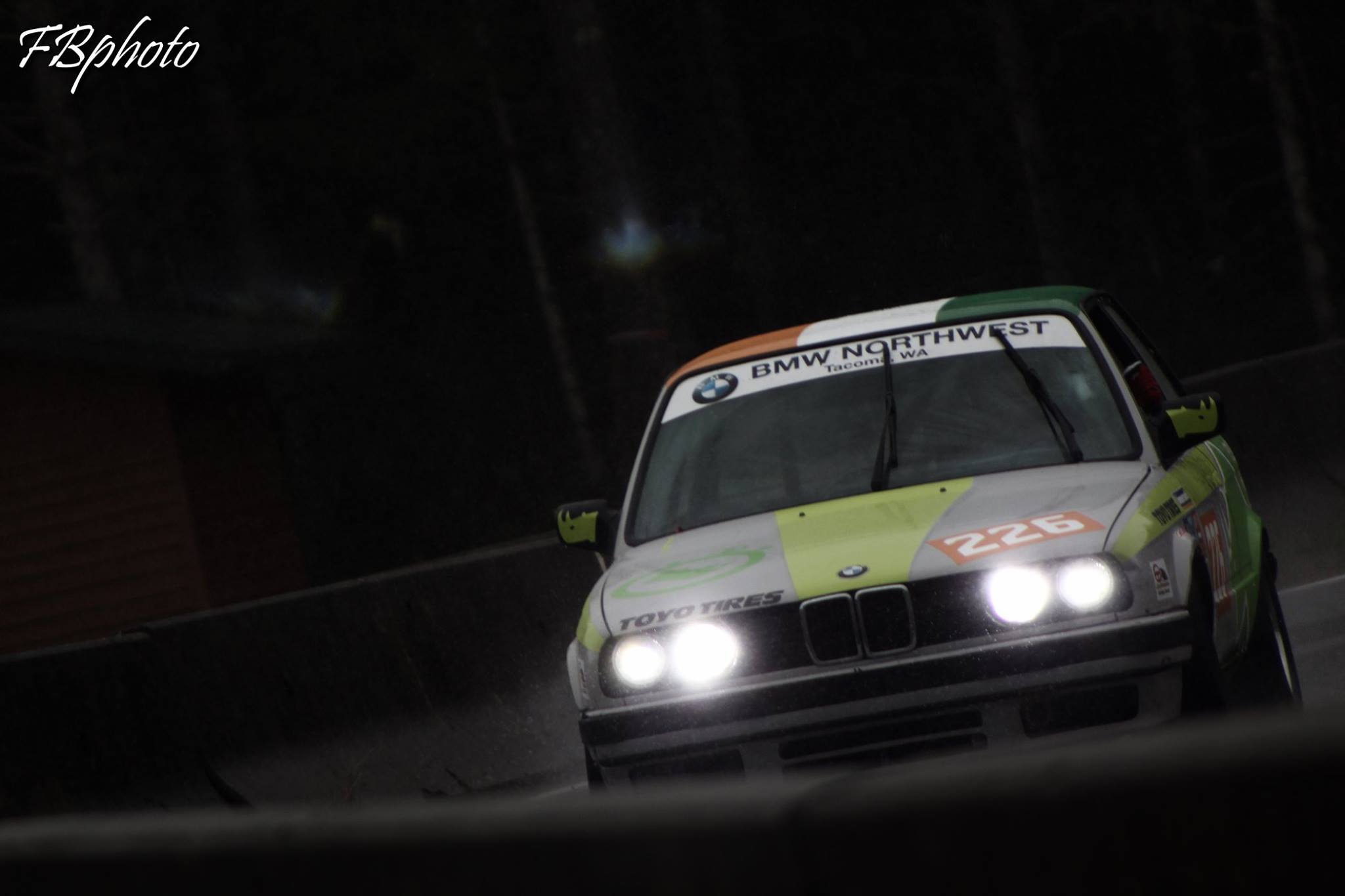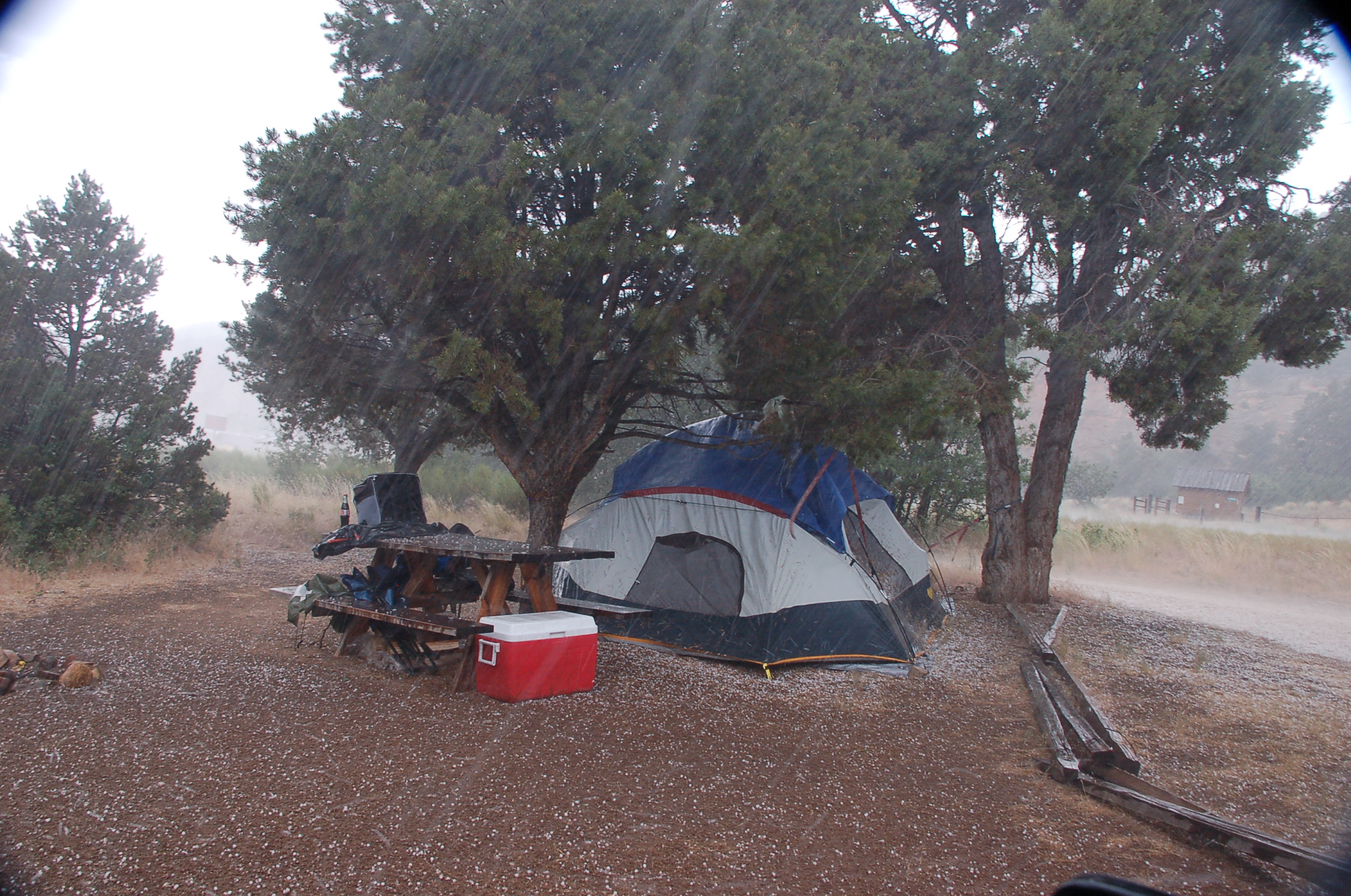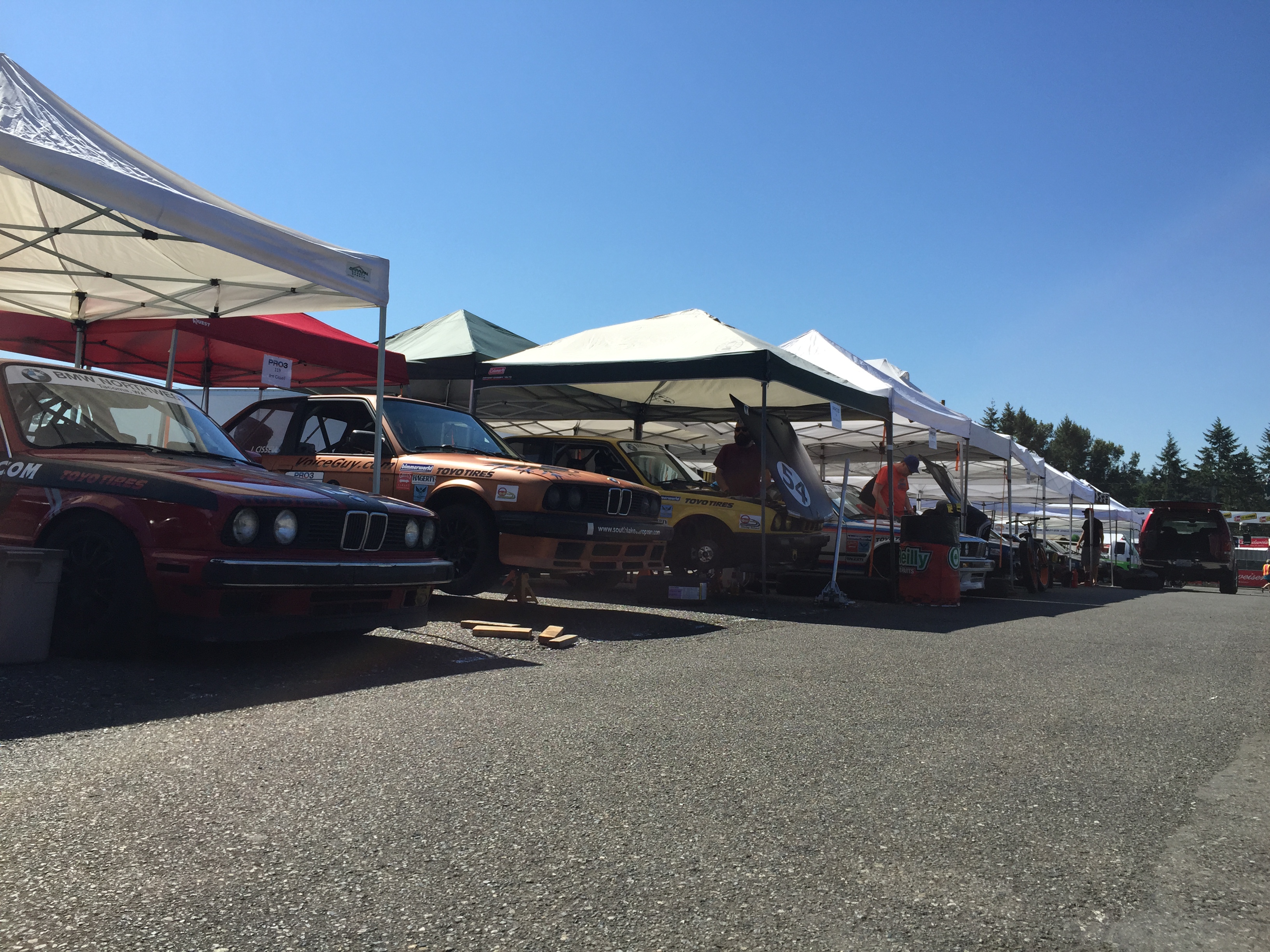
What: First race of the season, a 6 hour race at the Ridge Motorsports ‘water’ Park. Non-stop rain, great for driver development but sucked for everything else. Qualified on pole but finished 2nd in ME2 class.
If I knew then, what I know now: Check all vital systems at least a few days prior to the race weekend. Not having our radios and GPS receiver working caused us the win and this was all preventable.
Products that you should check out:
- Sampson Digital Pro Racing System – this is what we have, paired with an in-helmet speaker system on a Stilo helmet and an IMSA wiring adapter. When we test it and hook up properly, it works perfectly!
Background
April 30, 2017 marked the first race of the 2017 club racing season, the 6 Hours on the Ridge, held at the Ridge Motorsports Park in Shelton, WA and put on by the International Conference of Sports Car Clubs (ICSCC). For those of you who are not from the Pacific Northwest, in the United States, this sanctioning body probably doesn’t ring a bell.
The ICSCC operates in Oregon, Washington and British Columbia (Canada) as essentially a Sports Car Club of America (SCCA) but with not as much “politics”. This is primarily because it’s a smaller organization and thus, rule changes don’t impact as many people and there aren’t as many people lobbying for a change one way or another. They adopt and support most classes that exist in the SCCA and even NASA, such as Spec Miata, Improved Touring Classes, Spec E46 and so on.
The SCCA does exist in the PNW, it’s just not as strong, though it’s been growing the past couple years. NASA had a brief stint in 2013-2014. One series that is unique to the PNW and ICSCC is PRO3. It’s like Spec E30 but with more modifications allowed, based on an Improved Touring Class formula, has the largest car count in the PNW with over 80 race cars built and fields ranging from 15 – 45 depending on the weather. It also some of the best drivers, many of which have gone on to the professional ranks in IMSA and Pirelli World Challenge. The PRO3 car qualifies nicely in the E2 and ME2 classes for endurance races.

Our car – The Track Attack #226
For this race, we were fortunate to have on our best friends, Manu Yareshimi, run a team for second year in a row and going for repeat wins. Last year we campaigned his car in the same race and got first place in the E2 class!

Manu’s PRO3 car is one of the best built PRO3 cars ever, originally built by a previous owner who has moved on to Spec E46 and with the folks at Advanced Auto Fabrications doing all of the work. And they do top-notch work! It’s a front running car that has been taken cared. More on the #226 in a future post when we feature his ride.
The team
Being a 6 hour race and with rain, lots of rain, in the forecast, we felt like as few pit stops as possible and thus probably three, two-hour stints, across three drivers. That meant Manu, myself (Gama Aguilar) and 2016 PRO3 Champion and new Spec E46 driver, Olivier Henrichot. There’s one word to describe Olivier: fast. Just nasty, dirty and unapologetically, fast. Check out some of his race videos on his YouTube channel. He has or is close to having just about every PRO3 track record in the local tracks.

This was actually a re-do with Olivier as we were originally going to run the 8 Hour Festival of Endurance in October 2016 at Portland International Raceways but a freak storm that never lived up to it’s hype caused the race to get postponed and most of the drivers and crew weren’t able to make the new date happen.
Bryce, Jordan and friends were there, just as they have been for most of our races, making sure the car was running, we had a strategy and pit-stops were executed well.
Testing, practice, qualifying
We arrived on Saturday for a test-and-tune day, to not only shake down the car but beat the rust off of our driving skills as it was the first time any of use had done anything but sim racing in 2017. We had originally prepped the car for the 8 hour in October that didn’t happen and then it just sat in the garage. We drove and made some adjustments to try to dial out some front-end push, that would then be followed by some aggressive over-steer if we tried to coax the front end to bite. At the end of the day, we made compromises to allow the front end to have more bite, slow the weight transitions but not be too tail happy as not all of us had or have lightening hands, like Olivier.
We woke up Sunday morning to just clouds but then the first drop of rain started around 8:15am and did not let up the WHOLE DAY. We’re not talking showers or even steady rain, we’re talking downpours transitioning to monsoons and back to downpours. Aside from being wet and cold when not in the car, it was a blast!
We had a brief practice session where Manu and I split the time and then we put our hot-shoe in for qualifying. He not only put us on-pole for E2 but 7th overall, splitting half of the Spec E46 field! #winning

The race!
The race started in a steady rain and when the green flag dropped, the spray began and the race was on! The first hour went off with all but two things going as expected. That first thing, which at the time felt insignificant, ended up being the biggest lesson learned. The radios didn’t work. Well, at first it was that we when we did a test connection with Olivier’s helmet and the in-car radio system, the connectors on the system and his helmet weren’t compatible.

We brushed it off and just assumed that it would work with Manu’s helmet and mine, just like it had the past couple of years, without an issue. The first sign of this fatal flaw was about 90 minutes into his stint, we gave him a thumbs up as he passed start/finish. The very next time by, he comes into the pits to see what’s going on? There goes half of his almost one full lap lead.
20 minutes later, he comes in after going off to check things out and make sure there was no damage to the car. It all checked out and we decide to do a driver change since it was close enough to the 2 hour planned stint. Manu goes in, connect radios, turn them on and… nothing. Ok, we’re going off of pit boards only.
Separate story on Manu’s amazing comeback in a separate post but this was Manu’s first time in a race car in exactly one year and after recovering from a life-threatening disease. So he was working his way to getting back on pace. Slowly but steadily, his lap times were coming down, even with conditions getting worse but we lost the lead and because our main competition left their fastest driver in the car for about 3 hours (Corey Peters and the KD Motorsports crew), they eventually got two laps up on us.
An extended black flag all due to a car going into the start/finish wall stopped the bleeding and when racing got back underway, Manu had figured out how to drop another 8-10 seconds from his lap times – AWESOME!!
With about 2.5 hours left in the race, it was my turn. We tried the radios on my headset and nothing. No sweat – just focus on the goal: drive clean and take big chunks out of the 2 lap lead the competition had on us. The second hiccup we had was that the GPS receiver on the AIM MXL dash had bitten the dust. The last few times on track, the receiver was hit and miss but would always eventually get going. No matter, we strapped in Track Attack on iOS and got going.
Within a few laps, I started clipping away lap times in the mid 2:24-2:25 range on a consistent basis. The conditions were absolutely horrible. Fun but horrible. Aquaplaning on the front straight and the worst was near the top speed area, right before start/finish. A big puddle of water mid-track and the middle of the transition between T4 and T5. While not super tricky, exploring and searching for traction in the ‘carousal’, a long left-hand sweeper.
Then there was the worst part of the track in the rain, T9. A slight right hander, that we call ‘the kink’ because right at the corner there is curbing and an immediate uphill climb on the corner exit. This is great in the dry because you attack it hard, staying flat and using all that grip you get when hitting a steep uphill and on-camber climb. In the wet though and in these southeast Asia style monsoon conditions, a lake had formed as water collected from all directions and no drains for relief. It was kind of straight forward: no matter what you did, it was going to feel like hitting a standing water, at-speed, because that is exactly what we were doing and it was going to spit you out the other side and your only goal is minimize how sideways you would be spit out.

After the first 10 or so laps and a few full opposite lock situations, I thought I had it figured out but I would discover that what would work on one lap, had no guarantee of working another lap. I even resorted to attempting to follow the path of the Spec E46’s, who were placing their right tire on the curbing, claiming it had more grip but if you got it wrong, the penalty would be severe. I paid a severe penalty, barely being able to keep the car on-track. Despite all of this, I was making up ground fast, having made up one lap and more than halfway through making up the second lap. That progress wouldn’t end with what we wanted, over what ended up being the last 30 minutes of my stint, I ended up going off-track (even if it was just 2 wheels off) 4 times.
I eventually got the rolled up black flag, the last warning before being called into the pits and even though I backed off the pace, I still went off again, dropping two wheels on the exit of the kink. I didn’t know what was going on – almost whatever I tried, it would work one lap but not the other. I got black flagged for the first time ever. Had a good conversation with the race steward and promised to back off the pace even more, crawled through the kink on the out-lap. Made it! Ok and now early and soft brakes for the ‘thumb’ and… nothing. No slowing down, no lockup, no turning, no response to brake pedal modulating – just gliding straight off the track.
Embarrassed, confused and disappointed, I kept the car moving so I wouldn’t get stuck on the mud as I had gone a solid 50-75 feet off-track, got back on track and made my way back to the hot pits. I had the crew checkout the car and while they couldn’t find anything wrong, we saw a big dent in the skid-plate, mud and dirt everywhere and no way to explain what happened. So we figured we must have been leaking oil and called it a day.
Results
We finished 90%+ of the race laps so we classified in 2nd place. The 1st place KD Motorsports car would end having to be towed in 4 laps later but still winning overall. It turns out that they had a slow oil leak and eventually their engine seized – explaining part of why I went off so much; they had been dropping oil across the track for several laps. While that sure as heck didn’t help our cause, I put all the blame on us. We should have tested our radio setup the day before and gotten them working, so we could have been in communication with the pit wall and telling the race steward that not only were conditions difficult but that something else was up on the track.
We should have had lap times the entire time, with the crew checking lap times on Race Monitor to tell the drivers that we could slow down a bit and still make progress. This race was lost the day before and even the week before. We failed to prepare properly – we could have tested radios and GPS a week, a month, several months prior.



















